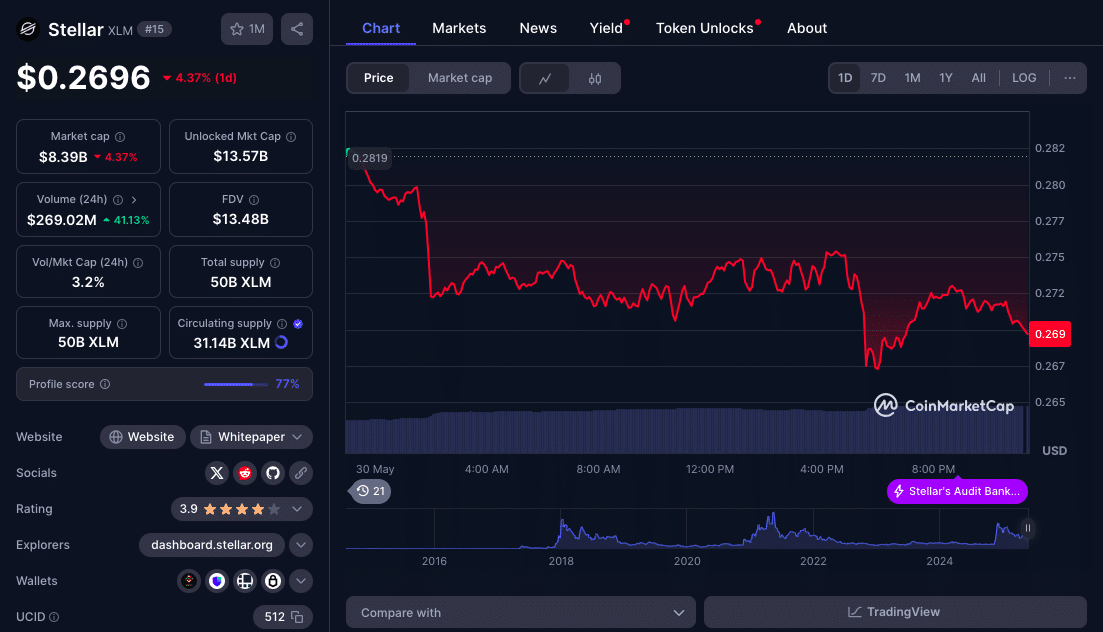Stellar (XLM) is a top blockchain for fast; low-cost cross-border payments and investors are paying attention as 2025 keeps unfolding and rolls into 2026. As at the time of this publication, XLM is trading at $0.2697; down 4.37% in the last 24 hours.
Despite this small dip, Stellar price is holding strong in the current volatile crypto market. Recent analysis says there’s bullish momentum and some expect a breakout to $0.30. With blockchain adoption and DeFi growing, Stellar’s unique features make it an asset to watch in the digital currency space.
Overview
Coin Name | Stellar(XLM) |
Price | $0.2696 |
Market Cap | $13.57B |
Volume(24hrs) | $269.36M |
Circulating Supply | 31.14B XLM |
All-time High | $0.9381 Jan 04, 2018 |
All-time Low | $0.001227 Nov 18, 2014 |
24hr High | $0.2799 |
24hr Low | $o.2671 |
Brief History of Stellar (XLM)
Stellar (XLM) was launched in July 2014 by Jed McCaleb and Joyce Kim under the Stellar Development Foundation (SDF); a non-profit aimed at democratizing finance. It uses the Stellar Consensus Protocol (SCP) for fast, secure transaction validation.
A core use-case is cross-border currency transfers: Stellar enables instant, low-cost exchange between fiat and crypto assets. Transactions cost only 0.00001 XLM, making micro-payments and remittances feasible.
Stellar has built-in tokenization and a decentralized exchange; it serves both unbanked populations and institutional clients (e.g. some large banks and payment firms have piloted on Stellar). XLM is the native token used for fees and as a “bridge” currency.
Notably, Stellar burned half of its original 100 billion supply in 2019, leaving about 31 billion XLM in circulation today. This burn and fixed supply explains XLM’s long-term value proposition.

The Stellar network is showing steady growth. SDF’s Q1 2025 report highlights 942,000 active addresses on Stellar (227,000 new in that quarter). DeFi and real-world asset (RWA) initiatives are expanding. Stellar maintained a number 2 global rank in tokenized government treasuries and launched on-chain RWA products (CETES, USTRY).
Through its HOT Wallet and integrations with payment services (e.g. MoneyGram’s remittance rails and new support for Circle’s USDC stablecoin), Stellar is targeting mass adoption.
The SDF’s strategy for 2025 explicitly prioritizes scaling DeFi TVL (target $1.5 billion) and real-world assets ($3 billion). These developments, that is, institutional partnerships and new crypto applications are going to be important to XLM’s long-term outlook.
Latest Developments (May 2025)
Based on available data, CoinDesk reported XLM’s 7% plunge amid high selling volume as Rain (a crypto debit card platform) announced support for Stellar alongside Solana and Tron. While the price drop looked bearish, analysts noted this Rain integration as a positive for mainstream adoption, enabling Stellar-backed stablecoins to be spent like cash.
SDF’s recent reports also show real-world progress. In Q1 2025, Stellar processed $3.4 billion in RWA payments (healthcare payrolls, humanitarian aid, etc.) and has $757 million in tokenized assets on-chain. On-chain payroll (e.g. a United Nations pilot in Syria) is a practical use-case. Monthly Active Addresses hit all-time high (ranked 23 by Nansen) and the mobile-friendly HOT Wallet now has 200k users. This is also good for the long-term.
Adding to these, Stellar is onboarding new asset issuers and developers. Multi-chain bridges and wallets (Telegram-based HOT Wallet, browser extensions) make it easier for new users to get into crypto. USDC and other stablecoins are heavily deployed on Stellar, driving transaction volume, and capturing more of the real-world finance market.
Current Technical Analysis
As of late May 2025, XLM is trading around $0.27–$0.29. Technical indicators are mixed:
200-day simple moving average (SMA) is around $0.255 and XLM is above it, hence support is in the long term uptrend. 9-period exponential MA is near $0.2939 and XLM is below it, revealing short term weakness.
RSI is moderate. Changelly reports RSI as approximately 45.6 which is neutral. Current analysis showed RSI of about 37.5 indicating weakening. RSI being below 50 but above 30 means coin is not overbought or deeply oversold, but momentum has cooled.
Traders saw bearish MACD crossover on XLM’s charts, which matches the recent pullback. Price is also down from early-May highs so there’s a near term pressure.

Short term XLM is range bound. Support is near $0.27–$0.276, which is also lower than Bollinger Band of $0.285. Resistance is around $0.28–$0.30 (9-EMA and prior swing highs). Below,$0.27, Stellar price could retest spring lows ($0.22–$0.24) according to long term trendlines. Overall short term is bearish, but long term (price >200-day MA) is constructive.
Expert Forecasts and Tables
Analysts’ predictions are mixed on XLM. Here are the 2025–2026 experts’ forecasts:
| Source/2025 | Low ($) | Avg ($) | High ($) |
| Changelly | 0.243 | 0.321 | 0.282 |
| CoinCodex | 0.269 | 0.324 | 0.387 |
| DigitalCoinPrice | 0.24 | 0.52 | 0.59 |
| Cryptopolitan | 0.36 | 0.45 | 0.54 |
| Coinpedia | 0.65 | 0.97 | 1.29 |
| Benzinga | 0.258 | 0.316 | 0.394 |
| Source/2026 | Low ($) | Avg ($) | High ($) |
| Changelly | 0.491 | 0.505 | 0.585 |
| CoinCodex | 0.287 | 0.388 | 0.561 |
| DigitalCoinPrice | 0.58 | 0.65 | 0.69 |
| Cryptopolitan | 0.66 | 0.75 | 0.84 |
| Coinpedia | 0.86 | 1.31 | 1.76 |
| Benzinga | 0.168 | 0.184 | 0.201 |
These are different forecasts from experts. CoinCodex and Changelly are moderate, DigitalCoinPrice and Cryptopolitan are moderate optimistic, Coinpedia is strong bull, Benzinga is bearish.
Stellar Price Prediction
| Year | Minimum Price ($) | Average Price ($) | Maximum Price ($) | Insights |
|---|---|---|---|---|
| 2025 | 0.35 | 0.52 | 0.78 | Analysts expect increased utility from real-world asset tokenization and growth in cross-border partnerships. AI-based models show potential for bullish momentum if BTC remains strong. |
| 2026 | 0.42 | 0.61 | 0.89 | Long-term forecasts point to progressive adoption. XLM may benefit from ongoing integrations, including stablecoin support and government collaborations. |

Short-Term vs Long-Term Stellar Price Prediction
In the short term (weeks to months) Stellar is cautious. Technicals are consolidating and XLM must hold $0.27 or will pull back deeper. The recent high-volume drop shows XLM is vulnerable to broad market moves. Many short-term forecasts expect only minor gains or losses by end-2025. But minor bull signals (e.g. price above 200-day MA) will limit downside.
For medium/long term (2025–26), more positive scenarios if catalysts come to life. If Stellar achieves its adoption goals and crypto markets recover XLM could hit the top end of the ranges. Coinpedia’s $1 by end-2025 or Cryptopolitan’s $0.75 by 2026 reflects this. But some forecasts (e.g. Benzinga’s 2026 projection $0.18) say be cautious if overall crypto cycle is weak. Overall Stellar’s partnerships, DeFi buildout and real world projects will be the deciders.
Factors Affecting Stellar Price Prediction
Here are a few factors that will impact XLM in 2025-26:
Adoption and Use-Cases: More usage of Stellar’s payment rails and DeFi features will increase demand. Partnerships with financial institutions (Stellar has worked with firms like JPMorgan and Visa pilots) and stablecoins (USDC, etc.) on Stellar will expand the use of XLM. SDF’s focus on real-world assets will underpin token demand.
Partnerships & Integrations: Rain card integration (May 2025) and similar announcements like anchor services in new countries will show XLM’s ecosystem growth. Merchant adoption of Stellar-based stablecoins for remittances or payroll will increase volume and sentiment.
Regulatory Climate: So far, Stellar has seen less regulatory heat than some tokens; it’s fully decentralized (no pre-mine) and hasn’t been directly targeted by regulators. Crypto-friendly or restrictive policies (SEC cases, Fed digital dollar) will impact all cryptos. Clarity on stablecoins or tokenized assets will favor XLM’s use-case.
Macro and Crypto Sentiment: General crypto market cycles play a role. Bullish macro (lower interest rates, risk-on flows) will lift altcoins like XLM.
Ecosystem Growth: Number of applications and assets on Stellar (TVL, wallets) is key. SDF’s 2025 targets are to be in Top 10 in TVL and 5 million monthly active wallets. Success on these will be bullish for XLM, stagnation will limit upside.
Tokenomics: XLM’s deflationary design puts a long-term positive pressure on price. Token allocation (market circulation vs reserves) means most XLM is already trading. Large token moves such as SDF selling program, if any will impact Stellr price, but no signs of massive sell pressure.
Conclusion
Stellar (XLM) has solid fundamentals; a feature rich blockchain for payments and tokenization, growing usage and fixed token supply. As of May 2025 the market is mixed on XLM. Technicals show short term weakness (bearish RSI/MACD) even as long term trends are intact. Some Expert forecasts for 2025–26 are bearish to while others are very bullish reflecting overall crypto market uncertainty.
For investors, the key takeaway is balance: watch Stellar’s network growth and partnerships as bullish signs, but be aware of the bigger market risks. If Stellar’s adoption in cross border payments and DeFi continues to accelerate XLM could hit the higher end of the forecasts (potentially $0.50–$1.00+ by 2026). If crypto markets stay weak, Stellar price might stay in the $0.20–$0.30 range.
In summary, Stellar price in 2025 and 2026 will be determined by its real world impact and overall market sentiment.
FAQs
What is Stellar (XLM) and what is it used for?
Stellar is a blockchain for fast, low cost financial transactions. Its native token XLM pays transaction fees and is a bridge in cross currency trades. Stellar is used for remittances, stablecoin transfers and tokenizing assets on chain.
How many XLM coins are there?
100 billion XLM were created initially but Stellar’s founders burned about 50 billion in 2019. Today there are about 31 billion XLM in circulation. No new inflation, supply is fixed.
What affects XLM’s price?
Network adoption, more Stellar usage equals higher demand, partnerships and integrations such as the Rain card support, crypto market cycle, regulatory news, macro trends. Stellar’s progress on DeFi and real world assets (TVL, active wallets) also affects sentiment.
Q: Will XLM hit $1?
Most analysts don’t see $1 in 2025-26. It depends on a strong crypto bull market and Stellar adoption. Short term resistance around $0.30 means $1 would require sustained rallies and positive catalysts.
Glossary
RSI (Relative Strength Index): momentum oscillator (0–100) measuring recent price changes.
MACD (Moving Average Convergence Divergence): trend indicator showing the relationship between two moving averages of price.
Support / Resistance: Price levels where buying (support) or selling (resistance) pressure tends to happen.
TVL (Total Value Locked): total value of crypto assets deposited in DeFi protocols.
RWA (Real-World Assets): Traditional assets (stocks, bonds, real estate) tokenized on a blockchain.
ROI (Return on Investment): Percentage gain or loss on an investment.
Sources
Disclaimer: This article is for informational purposes only and does not constitute financial advice. Crypto assets are volatile and speculative. Always conduct your own research before investing.



















































































































